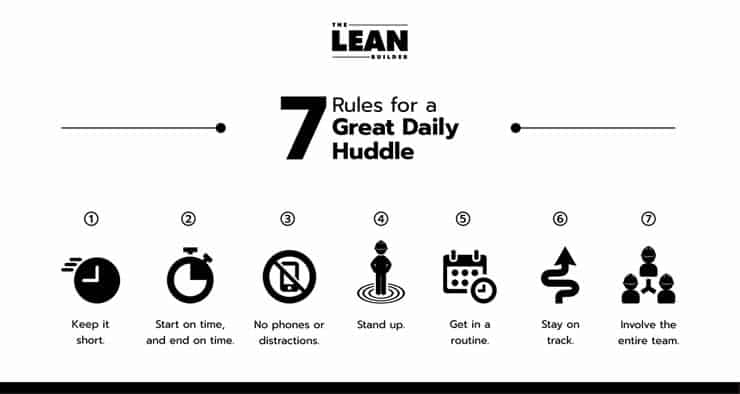Daily huddle rules are essential if you want your huddles to be productive and your trade partners engaged. Lean expert and co-author of The Lean Builder, Keyan Zandy, describes 7 rules you should implement in your daily huddles to increase the productivity of your meetings and your jobsite.
Daily Huddle Questions
Do your “subcontractor” or “field coordination” meetings seem unproductive? Do your trade partner foremen seem disengaged? Do topics take too long to close out—and when the meeting adjourns, do you feel like not much was accomplished?
If you answered “yes” to any of these questions, it might be time to shake things up with a daily huddle.
Whether you start or finish your day with a huddle, this meeting structure will facilitate more efficient communication, collaboration, and accountability. Here are 7 daily huddle rules to help keep your meetings on track and successful.
7 Daily Huddle Rules
A daily huddle should last no longer than fifteen-twenty minutes. Any longer than that, and you risk losing the attention and engagement of the meeting participants. An egg timer is a useful tool to help get the team into the practice and rhythm of a short meeting. This may seem strange to get used to at first, but the team will quickly realize what is most important and worth talking about during the brief daily huddle time.
There is a lot of value in starting and finishing your meeting on time. It fosters productivity, it makes a good first impression, and it shows you value your attendees’ time. And by continuously enforcing the promised time restraints, you demonstrate follow- through in keeping your word.
Everyone should participate and be engaged. Allowing participants to use their phones at the huddles shows a lack of respect to the team because it sets the expectation that the information on your phone is more important than the conversation in the meeting.
Remove the chairs from the meeting space so that everyone is standing. This will help keep everyone engaged as well as helping everyone stay focused on the topic/discussion at hand. If they are sitting back in a comfortable chair, attendees are more inclined to disengage and turn off their brains.
Have the trade leaders get in the habit of routinely answering the following questions at the daily huddle:
- What are you working on?
- Where are you working?
- How many crews/workers are on-site?
- What are your constraints/needs?
- What material deliveries are coming up?
By asking these five questions, you are engaging the trade partners and allowing them to collaborate and coordinate with the other trades. This achieves buy-in and accountability and allows for a more reliable workflow.
Without intent and discipline, it is very easy for a daily huddle to get off track. It is important to know which problems or conversations are not critical to moving the huddle forward. To maximize value, use the following terminology to make sure the time is well spent:
- Two Minute Rule / ELMO – If a topic has run its course, if a point has been made and it is time to move on, or if the issue or circumstance does not involve the entire team and can be resolved at a later time, any member of the huddle is empowered to call the Two Minute Rule, or ELMO (the two terms are interchangeable).
The Two Minute Rule means that the issue has been discussed for two minutes or longer and it needs to be put aside for now and resolved outside of the huddle. ELMO stands for Enough, Let’s Move On—playfully tossing a stuffed animal you’ve named “Elmo” at the speaker can be a fun way to break the tension of cutting someone off.
- The Parking Lot – Once the Two Minute Rule or ELMO has been called, those items need to be placed in “the parking lot.” (It is good practice to write parking lot items on a whiteboard as they arise so that they are not forgotten about.) Placing items in the parking lot means that a quick discussion will be held following the huddle with the affected people in order to discuss the issues or circumstances that did not require everyone’s involvement.
-
Involve the entire team.
Meetings will be even more productive if the general contractor’s project manager, assistant project manager, and/or project engineer are available to attend. They may have relevant information that the rest of the team does not have, and their participation can help provide faster resolutions on constraints that may involve the input of the design team or owner. When the trades see that the entire team is active in the process, it fosters buy-in.
If you have any Lean Daily Huddle tips, suggestions, or questions, we’d love to hear from you in the comment section.









